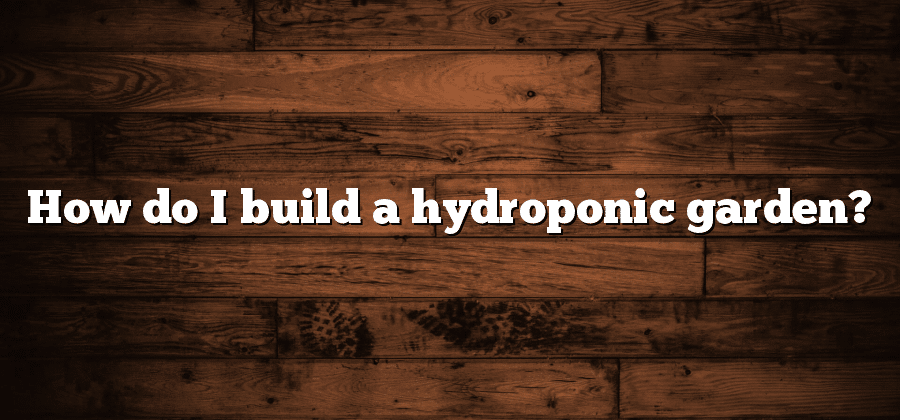Benefits of Hydroponic Gardening
One of the major benefits of hydroponic gardening is its ability to maximize plant growth and yield. Unlike traditional soil-based gardening, hydroponics allows for more control over the growing environment, including factors such as pH levels, nutrient composition, and water supply. By providing plants with the exact conditions they need to thrive, hydroponics can result in faster growth rates and healthier plants.
Another advantage of hydroponic gardening is its efficient use of resources, particularly water. In a hydroponic system, water is recirculated and reused, minimising water wastage compared to traditional gardening methods. Additionally, because the plants are grown in a soil-less environment, there is no risk of soil erosion or nutrient depletion. This not only reduces the need for fertilizers, but also helps to conserve natural resources and protect the environment.
Understanding the Basics of Hydroponics
Hydroponics is a modern method of growing plants that does not rely on soil for nutrient uptake. Instead, it utilizes a nutrient-rich water solution that is directly delivered to the roots. This revolutionary technique offers numerous benefits for both commercial and home gardeners.
One of the key advantages of hydroponic gardening is its ability to conserve water. Unlike traditional soil-based gardening, hydroponics utilizes a recirculating system that minimizes water waste. The water is constantly filtered and reused, resulting in significant water savings. Additionally, with hydroponics, plants receive water directly to their roots, reducing the risk of evaporation and ensuring optimal hydration. This makes hydroponic gardening a sustainable and eco-friendly alternative to conventional gardening methods.
Choosing the Right Hydroponic System
When it comes to choosing the right hydroponic system for your needs, there are several factors to consider. One of the first things to think about is the size and space available for your hydroponic garden. If you have limited space, a smaller system such as the nutrient film technique (NFT) or a vertical garden may be ideal. On the other hand, if you have ample space and are looking to grow a larger variety of plants, a larger system such as a deep water culture (DWC) or an ebb and flow system could be a better fit.
Another important consideration is the level of experience and expertise you have in hydroponic gardening. If you are a beginner, it may be advisable to start with a simpler system such as a wick system or a kratky method. These systems require less maintenance and monitoring, making it easier for novices to get started. However, if you have more experience and are familiar with the intricacies of hydroponic gardening, you may prefer a more advanced system like aeroponics or a drip system.
Ultimately, the choice of hydroponic system will depend on your specific needs and preferences. It is important to carefully consider factors such as space, experience level, and the plants you wish to grow before making a decision. By selecting the right system, you can ensure optimal growth and success in your hydroponic garden.
Essential Components for a Hydroponic Garden
In order to have a successful hydroponic garden, there are several essential components that you will need to consider. First and foremost, you will need a reliable hydroponic system. There are many types of systems available, each with its own advantages and disadvantages. It is important to choose a system that suits your specific needs, whether it is a simple drip system or a more complex nutrient film technique.
Another crucial component for your hydroponic garden is a suitable growing medium. Unlike traditional soil-based gardening, hydroponic gardens rely on different materials to support the plants. Some popular growing mediums include rockwool, perlite, vermiculite, and coco coir. Each medium has its own properties, such as water retention and aeration, which can affect the growth of your plants. It is important to choose a growing medium that provides the optimal balance for your plants.
Selecting the Ideal Location for Your Hydroponic Garden
When it comes to selecting the ideal location for your hydroponic garden, there are a few factors to consider. Firstly, you want to find a space that receives ample sunlight. Most plants require at least six hours of direct sunlight per day, so choose a location that is not obstructed by tall buildings or trees. If you don’t have access to natural sunlight, artificial lighting can be used, but it is not as effective as sunlight.
Secondly, ensure that the location you choose has a stable temperature. Hydroponic plants thrive in temperature ranges between 65°F and 75°F (18°C and 24°C). Avoid areas that are prone to extreme temperature fluctuations, such as near heating or cooling vents. Consistency is key in maintaining a healthy and productive hydroponic garden.
Additionally, consider the accessibility and proximity of the location. It should be easily reached for watering, monitoring, and maintenance purposes. You don’t want a location that involves obstacles or long distances to tend to your plants regularly.
Lastly, take into account the available space. Hydroponic systems come in various sizes, so be sure to select a location that can accommodate the chosen system. The space should allow for proper installation and expansion, if desired. Remember to consider the height as well, as some plants may require vertical space to grow properly.
Overall, selecting the ideal location for your hydroponic garden is crucial for the success of your plants. By considering factors like sunlight, temperature, accessibility, and available space, you can create an optimal environment that promotes healthy growth and maximum yield.






